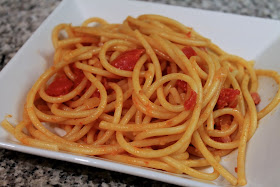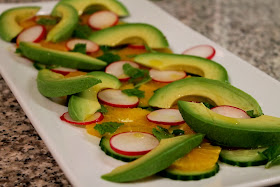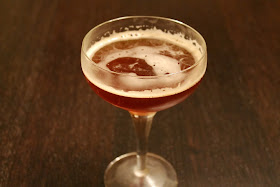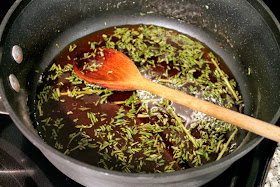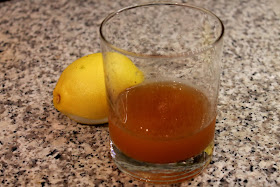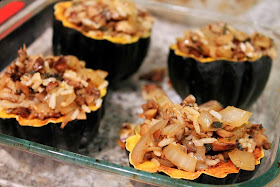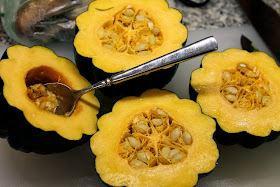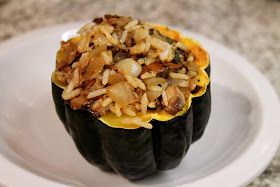Pages
▼
Thursday, October 31, 2013
Shaved Delicata Squash Salad
One of the standout dishes from our recent dinner at Grüner was my starter salad of shaved delicata squash, which inspired this salad recipe.
I've said before that restaurants are a major source of inspiration for me. They're also educational, or at least trying to replicate techniques from a restaurant is a great learning experience.
At the time of our dinner, I had assumed the squash on my salad was raw. After shaving some raw delicata squash and tasting it, I realized it couldn't have been. The raw squash, while edible, was far too tough to have been the tender shavings I'd enjoyed in my salad. If I was going to make a salad inspired by that dish, I'd have to improvise.
I decided to steam the squash briefly. I tested a couple pieces steamed for 1 minute and found them to be too soft. So I tried again for just 30 seconds and they were perfect. Tender enough for the salad but still had their structure.
I used a vegetable peeler to make the shavings. After first removing the peel, I just continued shaving off long strips of about 1/2- to 1-inch width until I got down to the part with the seeds.
Shaved Delicata Squash Salad
1 delicata squash
1/3 cup walnuts
2 handfuls of baby arugula
4 or 5 radishes, thinly sliced
1/4 cup grated ricotta salata cheese
2 tsp. balsamic vinegar
3 tbsp. extra-virgin olive oil
Salt and freshly ground black pepper, to taste
2 tbsp. fresh chopped chives
1. Peel the squash and discard the peel. Using a vegetable peeler, shave long, thin slices the length of the squash about 1/2- to 1-inch wide. Put a steamer insert in a medium saucepan, fill with water to just below the steamer level and bring to a boil. Steam the squash shavings for 30 seconds (I recommend doing it in 2 or 3 batches). Remove the shavings and plunge in ice water or put in the freezer to quickly chill.
2. Heat a small frying pan over medium-low heat. Toast walnuts until fragrant, tossing occasionally. Set aside to cool.
3. In a large bowl, combine baby arugula, radishes, ricotta salata, cooled squash shavings and cooled walnuts. Whisk together vinegar, olive oil, salt and pepper. Pour dressing over salad and toss to combine. Serve in shallow bowls topped with a sprinkle of fresh chives.
A Second Round of Oregon IPAs
Following up on last year's post on Oregon craft ales, this year, during our annual fall trip to the state, we tackled a slate of IPAs to find our favorite for the season. We were surprised to find that last year's favorite, the Total Domination IPA by Ninkasi, while still good, was no longer our favorite this year. Instead that honor went to ...
Chasin' Freshies, fresh hop IPA, Deschutes Brewery. ABV (alcohol by volume): 7.2%. IBUs (international bittering units): 65. Our favorite IPA was this seasonal fresh-hopped selection from Deschutes Brewery. It's a nicely hoppy beer but with fruity, floral notes too. Clean and crisp with good body. Loved it so much I went back to the store and bought a second bottle.
Breakside IPA, Breakside Brewery. ABV: 6.5%. This one doesn't appear in the photo above since I had it on tap at Bar Carlo. Like this Chasin' Freshies, this is another very hoppy beer that's nicely balanced with fruit. It's definitely got the bitterness of an IPA but more quite refreshing too.
Apocalypse IPA, 10 Barrel Brewing Co. ABB: 6.8% IBUs: 70. This one didn't have the "wow" factor like Chasin' Freshies or Breakside, yet I found myself reaching for it again and again throughout the week. It's a nicely balanced IPA, with fruit and malt flavors balancing the bitterness.
Total Domination IPA, Ninkasi Brewing Company. ABV: 6.7%. IBUs: 65. Still strong enough to satisfy any hophead. This beer is bitter. Not particularly fruity or malty. It's all hops with a perfect medium body. I still enjoyed it, but it wasn't my favorite this year.
Hopworks IPA, Hopworks Urban Brewery. ABV: 6.5%. IBUs: 70. Despite its stated IBUs, this one didn't seem as bitter to me as several of the others. Body is on the lighter side with hints of fruit and citrus.
Bridgeport IPA, Bridgeport Brewing Company. ABV: 5.5%. IBUs: 50. The lower IBUs really shows here. It's much less assertive than the other beers. So, while perhaps not a choice for hop-heads, it's still a nicely balance beer with hints of fruit and malt.
Wednesday, October 30, 2013
The Feed: October 30, 2013
The Feed is my weekly round up of interesting food-related stories from newspapers, magazines, blogs and websites.
Wired: “25 Amazing Food Infographics, Drawn From 49,733 Recipes,” by Cliff Kuang.
Data geeks, food lovers and especially food-loving data geeks like me will enjoy this wonderful set of infographics developed from a “scrape” of the data on the tens of thousands of recipes available from the Food Network website. The graphics themselves are beautifully designed and include many great nuggets: most recipes for similar dishes are better liked if they include bacon (except pastas), Chef Jeff Mauro’s recipes are rated the best and Chef Alton Brown is pretty consistently good at everything. Best of all is the giant graphic plotting all the recipes that shows number of reviews, rating and number of ingredients, labeled with cool highlights like the “most reviled recipe” (Pastel Puertorriqueño, a dish that contains ham, raisins, olives and bananas) and the highest rated (Turkey with Herbes de Provence and Citrus)
CNN Eatocracy: “Build me up, peanut butter cup,” by Sarah LeTrent.
I got excited when I read this recipe article. Really excited. Basically, this tells you how to make peanut butter cups at home, which is an incredibly good idea. I love peanut butter cups. They are my favorite candy, and I don’t eat a lot of candy. They’re also kind of a mystery, so reading about how they work was a real treat. Making and eating them will be an even better treat though. Can’t wait to try this.
New York Times: “What’s for Dinner: Anchovies Elevate a Pan-Seared Chicken Dish,” by Melissa Clark.
Clark had a piece recently praising anchovies that I neglected to include in The Feed. She revisits the flavorful little fishes this week as a booster in a recipe for simple pan-seared chicken thighs, along with capers, garlic and lemon (sounds good, doesn't it?). Clark recommends serving this with a crusty bread to soak up the sauce. With some simply dressed greens you’d have a perfect weekday dinner. The accompanying video is really great too. Clark is a natural on camera; she looks like she’s really enjoying the chicken, and it made me really hungry watching her cook it.
Washington Post: “The Veg-O-Matic: It slices and dices as well as it ever did, which means not well at all,” by David Hagedorn.
Hagedorn’s review of the new but apparently not improved Veg-O-Matic is hilarious. He includes a nice dose of ‘70s nostalgia recounting how he used to recite the device’s TV ads as a child. Apparently its promises to easily dice and chop are overstated though, as he made a mess of quite a few vegetables. At least he got a nice fall soup out of it, although I can’t say I’m surprised the recipe doesn’t mention dicing by Veg-O-Matic. I’m reading Bee Wilson’s Consider the Fork right now, a history of kitchen equipment. I’m guessing this device won’t warrant a mention.
NPR: “How A Portland Cook Became A 'Proud Copycat' Of Thai Food,” by Joel Rose.
It’s no secret that Portland’s restaurant scene is red hot these days. And there’s no chef from my Pacific Northwest birthplace hotter than Andy Ricker, whose restaurant Pok Pok and its spin offs in Portland and New York have heralded a new generation of Thai cooking in America. Rose nicely summarizes Ricker’s life story and rise to prominence, including a great quote from the former Oregonian food critic about the food at Pok Pok (“It marched into your mouth like sour bombs, and fire, and like more funk than a James Brown record”).
Wall Street Journal: “Slow Food Fast: Four-Cheese Polenta with Chanterelle Ragout,” by Kitty Greenwald.
Speaking of cool Portland chefs, this week's Slow Food Fast recipe in the Journal is from Chef Cathy Whims of Nostrana. Her polenta with chanterelle mushrooms sounds really delicious, probably because it's made with so much cheese she says its almost a cross with fondue.
CNN Eatocracy: “5 foods you should eat this fall,” by Keri Gans.
Eatocracy has compiled a nice list of tasty seasonal vegetables and ways to really enjoy them (like roasted Brussels sprouts and poached pears). An accompanying gallery includes photos of 15 fall superfoods.
Tuesday, October 29, 2013
Gingersnaps
For these gingersnaps I was after something pretty specific: I wanted a cookie that was more crunchy than chewy and had good but not overpowering ginger flavor. I researched ingredients for a number of recipes. What I ended up with was closest to Smitten Kitchen's gingersnaps recipe.
First time I made this, they came out chewier than I wanted. Less cooking time will result in a chewier cookie. The second time I tried the recipe, I flattened the dough balls so they cooked up thinner, in addition to cooking them a bit longer, which resulted in the crunchy gingersnap I wanted.
Gingersnaps
Adapted from a recipe by Smitten Kitchen.
2 cups all-purpose flour
1 tsp. baking soda
1/4 tsp. salt
3 tsp. ground ginger
1 tsp. ground cinnamon
12 tbsp. butter (1 1/2 sticks)
1/2 cup sugar
1/2 cup light brown sugar
1 large egg
1/4 cup molasses
1. In a medium bowl, whisk together flour, baking soda, salt, ginger and cinnamon.
2. Add butter, sugar and brown sugar to a bowl of a stand mixer (or mix in a large bowl with a hand mixer). Beat until fluffy, about 3 minutes on medium speed. Add egg and molasses and beat until combined. Add dry ingredients and stir with a wooden spoon until just combined. Form dough into a large ball, wrap with plastic wrap and chill for at least 2 hours, up to 1 day.
3. Preheat oven to 350 F.
4. Roll dough into 1-inch balls, place on baking sheets about 2 inches apart and flatten slightly. Bake for 13 to 16 minutes until desired doneness (less baking time for chewier cookies; more for crunchy ones). Cool on baking sheets for 5 minutes then transfer to a rack to cool completely. Store in the fridge.
Monday, October 28, 2013
Beet salads
My mother grows purple beets in her garden. They are absolutely delicious. She made these salad recipes really easy by having already cooked the beets when I showed up recently. They need only a simple preparation: steaming or roasting (here's a beet salad where I roasted them).
For these salads, I played on the classic beet-walnut-goat cheese trio. The first salad is simpler, pairing the trio with peppery arugula and sweet dried cranberries. For the second one, I added two other treats from her garden: carrots and figs, plus some prosciutto. In both cases, the earthiness of the beets plays well with the other sweet, savory and bitter flavors.
Arugula and Beet Salad
1/3 cup walnut halves
1 cup cooked beets (about 3-4 beets, steamed or roasted and peeled)
3 cups baby arugula leaves
1/3 cup dried cranberries
2 oz. chèvre goat cheese, crumbled
2 or 3 tbsp. extra-virgin olive oil
1 tbsp. red wine vinegar
1/2 tsp. honey
Pinch of salt
1/2 tsp. dried thyme
Freshly ground black pepper, to taste
1. Heat a small frying pan over medium-low heat. Toast walnuts, stirring occasionally, until fragrant, about 8 minutes (watch to prevent burning). Set aside to cool then coarsely chop.
2. Cut beets into 1/2-inch cubes. Add to a large bowl, along with the arugula, dried cranberries, goat cheese and chopped walnuts.
3. Whisk together olive oil, vinegar, honey, salt, thyme and pepper. Pour over salad and toss to combine.
Beet, Fig and Prosciutto Salad
1 cup cooked beets (about 3-4 beets, steamed or roasted and peeled), cut into 1/2-inch cubes
8 fresh figs, quartered
1/4 cup walnut pieces
1 carrot, peeled and shaved or cut julienne
2 oz. chèvre goat cheese, crumbled
4 oz. prosciutto, cut into thin ribbons
2 tbsp. extra-virgin olive oil
1 tbsp. red wine vinegar
Salt and freshly ground black pepper, to taste
Combine beets, figs, walnuts, carrot, goat cheese and prosciutto in a large salad bowl. Whisk together olive oil, vinegar, salt and pepper. Pour dressing over salad and toss to coat. Serve in large shallow bowls.
Saturday, October 26, 2013
Remembering Marcella Hazan: Pasta all'Amatriciana
“Do not be alarmed by the amount of garlic this recipe requires.”
This line caught my eye and made me chuckle. It’s on the opposing page in Essentials of Italian Cooking from the recipe I made below, in reference to the 5 cloves of garlic in "Tomato Sauce with Garlic and Basil." With a title like that, you might expect a whole head in the sauce, but Ms. Hazan is being polite and reassuring a perhaps novice Italian cook into realizing that garlic, off-putting to some for its pungent aroma, isn't to be feared. It's the sort of instructional role she was perhaps best known for.
Marcella Hazan died in September at age 89. She had a remarkable life story, retold quite nicely by both Kim Severson for the New York Times and Bonnie S. Benwick for the Washington Post, but was best known for her cookbooks like her 1973 work, The Classic Italian Cook Book, which are regarded as instrumental in introducing American cooks to traditional Italian techniques.
Having made several of her recipes now, I'm most struck by her judicious use of liquid for concentrating flavor. A lot of pasta sauce recipes will have you sauté the vegetables, add broth and cover to simmer. Not Ms. Hazan. She makes a point of not covering sauces so that as the water evaporates, the flavors are concentrated. It makes a lot of sense. Her recipe for bolognese sauce I made earlier this year is shockingly dried but bursting with flavor. The pasta e fagioli soup has so little broth, it's really more like stew. Both dishes were absolutely delicious and I'd make them again in an instant. Well, not exactly an instant, as they both take some time to prepare, which is another key piece of wisdom from the Hazan kitchen: don't rush things.
Tonight, food writer Cathy Barrow of Mrs. Wheelbarrow's Kitchen is hosting a virtual dinner party to honor Marcella Hazan's memory. She is encouraging anyone who wants to participate to share their work through social media with the hashtag "#dinnerwithMarcella." I have other plans tonight, but I wanted to offer this recipe as my contribution to Cathy's inspired effort to help make sure that Ms. Hazan's memory lives on through the delicious legacy she's left us. There's definitely going to be some great smelling kitchens this evening.
This amatriciana typifies a lot of what I've seen of her dishes. It's relatively simple. Just a few ingredients. Few embellishments: no herbs, garlic or extra spices. But the flavor was of this sauce was amazing. One of the most satisfying bowls of pasta I've made this year. I changed only a few things. Since I really like the technique, I boiled my pasta 2 minutes short of al dente and finished cooking it in the pasta sauce. Because of the space needs of this technique, I cooked the sauce in a Dutch oven rather than the saucepan Hazan called for (Hazan liked to cook a lot of things in saucepans, a habit that Severson recounts made for an amusing argument between her and Mario Batali). I also reserved a bit of the tomatoes' sauce to thin out the sauce in case it got a little too dry (I added about 1/4 cup, so not too much, but I think it helped).
Marcella Hazan died in September at age 89. She had a remarkable life story, retold quite nicely by both Kim Severson for the New York Times and Bonnie S. Benwick for the Washington Post, but was best known for her cookbooks like her 1973 work, The Classic Italian Cook Book, which are regarded as instrumental in introducing American cooks to traditional Italian techniques.
Having made several of her recipes now, I'm most struck by her judicious use of liquid for concentrating flavor. A lot of pasta sauce recipes will have you sauté the vegetables, add broth and cover to simmer. Not Ms. Hazan. She makes a point of not covering sauces so that as the water evaporates, the flavors are concentrated. It makes a lot of sense. Her recipe for bolognese sauce I made earlier this year is shockingly dried but bursting with flavor. The pasta e fagioli soup has so little broth, it's really more like stew. Both dishes were absolutely delicious and I'd make them again in an instant. Well, not exactly an instant, as they both take some time to prepare, which is another key piece of wisdom from the Hazan kitchen: don't rush things.
 |
| I used San Marzano tomatoes, the popular imported Italian canned tomatoes. |
Tonight, food writer Cathy Barrow of Mrs. Wheelbarrow's Kitchen is hosting a virtual dinner party to honor Marcella Hazan's memory. She is encouraging anyone who wants to participate to share their work through social media with the hashtag "#dinnerwithMarcella." I have other plans tonight, but I wanted to offer this recipe as my contribution to Cathy's inspired effort to help make sure that Ms. Hazan's memory lives on through the delicious legacy she's left us. There's definitely going to be some great smelling kitchens this evening.
 |
| Be sure to simmer the sauce uncovered, so that its flavor concentrates as the liquid evaporates. |
This amatriciana typifies a lot of what I've seen of her dishes. It's relatively simple. Just a few ingredients. Few embellishments: no herbs, garlic or extra spices. But the flavor was of this sauce was amazing. One of the most satisfying bowls of pasta I've made this year. I changed only a few things. Since I really like the technique, I boiled my pasta 2 minutes short of al dente and finished cooking it in the pasta sauce. Because of the space needs of this technique, I cooked the sauce in a Dutch oven rather than the saucepan Hazan called for (Hazan liked to cook a lot of things in saucepans, a habit that Severson recounts made for an amusing argument between her and Mario Batali). I also reserved a bit of the tomatoes' sauce to thin out the sauce in case it got a little too dry (I added about 1/4 cup, so not too much, but I think it helped).
Pasta all'Amatriciana
Adapted from Amatriciana – Tomato Sauce with Pancetta and Chili Pepper from Essentials of Italian Cooking by Marcella Hazan
2 tbsp. vegetable oil
1 tbsp. unsalted butter
1 medium onion, chopped fine
2 oz. pancetta, cut into cubes of about ¼-inch
28 oz. can imported Italian plum tomatoes, drained (juice reserved) and diced
Generous pinch of red chili pepper flakes
Salt, to taste
1 lb. bucatini pasta (may substitute another pasta, such as penne)
1 lb. bucatini pasta (may substitute another pasta, such as penne)
3 tbsp. grated parmigiano-reggiano cheese
2 tbsp. grated pecorino romano cheese
1. Heat oil and butter in a Dutch oven over medium heat. Add onion and sauté until softened and the onion turns a pale shade of gold. Add pancetta and cook for about a minute, stirring a couple times. Add tomatoes, chili pepper flakes and salt. Reduce heat and cook uncovered at a gentle simmer for 25 minutes, adding additional reserved tomato juice if needed (I added about 1/4 cup). Taste and adjust salt and chili pepper as needed.
2. While the sauce cooks, bring a large pot of salted water to boil. Cook according to package directions for al dente, stopping 2 minutes short. Drain pasta and add to the Dutch oven with the sauce. Stir to coat pasta evenly and cook its final 2 minutes in the sauce. Turn off the heat, add the cheeses and stir to combine. Serve in shallow bowls.
Orange and Cucumber Salad
Adapted from Essentials of Italian Cooking by Marcella Hazan
I served this simple salad with the pasta. As suggested by Eat Drink Garden, I added avocado.
1 seedless cucumber
2 oranges
6 radishes, thinly sliced
1 avocado, peeled and cut into wedges
Clump of fresh mint leaves
Kosher salt, to taste
Extra-virgin olive oil (about a tablespoon or a little more)
Juice from 1/2 fresh lemon
Slice the cucumber into thin discs a arrange on a platter. Peel the orange and cut off any pith, then slice the orange into thin rounds and arrange on top of the cucumber. Top with slices of radish, avocado wedges and torn mint leaves. Sprinkle with salt, drizzle with olive oil and squirt with fresh lemon juice.
Friday, October 25, 2013
The Holzfäller (Woodsman) Cocktail
I named this cocktail The Holzfäller, which is German for "woodsman" for a few reasons. Principally, it was inspired by my recent dinner at Portland's Alpine-themed restaurant Gruner. Two of its ingredients come from the Alpine region: Austrian Nux Alpina walnut liqueur and French Dolin Rouge sweet vermouth. Additionally, the smoked whiskey and homemade rosemary-brown sugar syrup are woodsy flavors in my mind. This cocktail is pretty potent, but sweet enough that it makes for mellow sipping.
The Holzfäller (Woodsman) Cocktail
1 1/2 oz. Corsair triple smoke whiskey
1/2 oz. Nux Alpina walnut liqueur
1/2 oz. Dolin Rouge sweet vermouth
1/2 oz. rosemary-brown sugar syrup (see recipe below)
Fill a cocktail shaker halfway with crushed ice. Add whiskey, walnut liqueur, sweet vermouth and syrup. Shake until cold and strain into a chilled coupe.
Rosemary-Brown Sugar Syrup
3/4 cup light brown sugar
3/4 cup water
2-3 tablespoons chopped fresh rosemary, plus stems
Combine ingredients in a medium saucepan, including the rosemary stems. Bring to a boil, stirring until the sugar has dissolved. Reduce heat to low and simmer for 5 minutes, then remove from heat and steep for 15-20 minutes. Allow to cool and strain into a container for storage in the refrigerator.
Thursday, October 24, 2013
Restaurant: Grüner (Portland, Ore.)
Update: Gruner has closed.
Enduring restaurant talent is a remarkable thing, something I got to enjoy recently at Grüner, where Chef Christopher Israel has found the latest outlet for his amazing cooking.
Although you may have read my restaurant reviews on Cook In / Dine Out, only a select few of you may have read the reviews I wrote 20 years ago as the restaurant critic for my high school newspaper (cushy post, but as I was editor-in-chief, I had an in with the boss). The most memorable restaurant I wrote about at that time was Zefiro, a standout in the trendy dining scene that sprouted up around Portland's 21st and 23rd Avenues in the early '90s.
As overseen by Israel, Zefiro was, at the time, exotic and revolutionary for its eclectic international tastes and simple, fresh ingredients. Certainly as a young person who, up to that, had not been a very adventurous eater, it was a revelation. I can still remember what I ate and loved when I visited: grilled chicken skewers with an Algerian spice marinade and Turkish coffee ice cream with cookies. It was so good! (Here's a nice look back from Eater PDX).
Whereas Zefiro drew its inspiration from the countries that ringed the Mediterranean Sea, Grüner heads north a bit into Europe's Alpine region, blending flavors from southern Germany, northern Italy, France and others with a foundation of locally sourced Pacific Northwest ingredients.
 |
| Shaved delicata squash salad with ricotta salata, pumpkin seeds, cider vinegar, pumpkin seed oil and herbs |
We began the evening with cocktails. I enjoyed the Hangman's Nüsse, a potent bourbon cocktail flavored with the Italian aperitivo Cocchi Americano and walnut liqueur. As good as it was, I was more impressed with Chris's Roots of Auvergne, a gin cocktail with Salers, a liqueur made from the root of the Gentian plant that grows in the French region of Auvergne (hence the name). With white vermouth and lemon verbena balm, the drink had a wonderful vegetal quality.
 |
| Tarte flambée with sweet onions, bacon, fromage blanc and chives |
Among our starters, the shaved delicata squash salad was the most beautiful, with the yellow-orange squash shaved into pasta-like ribbons and topped with ricotta salata, pumpkin seeds, a mix of herbs and a dressing of cider vinegar and pumpkin seed oil. Our favorite was the tarte flambée, a sort of flatbread pizza with wonderfully meaty bacon and sweet onions. In contrast, the "Grüner" salad seems a rather tame mix of fresh garden vegetables, but I loved its heavy dose of red wine vinegar. I should also note the delicious bread basket that came out about this time, featuring a pretzel roll and whole grain bread, both of which were great.
 |
| House-made bratwurst and saucisson sausages with sauerkraut and potatoes |
For our entrees, we turned our attention to pork big time. Hard to say what was my favorite here, although probably the house-made bratwurst sausages my mom had (yes, my mom was with us, which was great fun), which were served with (also house-made) sweet and sharp grain mustard, sauerkraut with pickled peppercorns and yukon gold potatoes. Chris's choucroute garnie plate, which featured a mix of meats (including the bratwurst), included a sweet-glazed piece of melt-in-your-mouth pork belly. I enjoyed a refreshingly not overcooked pork chop with red cabbage, herbed spätzle (which is like pasta if you've never had it) and wild plum preserves. My Bavarian mixed grill also included a weisswurst sausage, which was the only thing that didn't wow me, since it's comparatively bland next to the other more flavorful meats we enjoyed.
 |
| Bavarian mixed grill: pork chop, weisswurst sausage, spiced red cabbage, spätzle and plum preserves |
We concluded our dinner with a slice of hazelnut and brown butter cake with goat cheese accompanied by a pear sorbet quenelle, bits of hazelnut brittle and a swirl of caramel. The tasty treat was just as satisfying as the dinner that preceded it.
 |
| Hazelnut-brown butter cake with goat cheese, pear sorbet, hazelnut brittle and caramel |
My lunch at Zefiro as a teenager was one of my earliest memories of enjoying a really good meal at a time when I was learning to care about good, quality food. Fast forward about 20 years and Chef Israel wowed me again, proving himself a master at manipulating cuisines of various provenance into a unified, delicious meal. The dinner was one of the best restaurant outings we've enjoyed in months.
Grüner, 527 SW 12th Avenue (at Alder Street), Portland, Oregon (downtown). (503) 241-7163. Reservations: Open Table.

Wednesday, October 23, 2013
The Feed: October 23, 2013
The Feed is my weekly round up of interesting food-related stories from newspapers, magazines, blogs and websites.
New York Times Magazine: "Food & Drink Issue: The Octopus That Almost Ate Seattle," by Marnie Hanel.
Sunday's New York Times Magazine, its annual food and drink issue, had a lot of interesting stories focused on the restaurant business. I particularly enjoyed the pictoral search for acceptable glassware and cutlery for the forthcoming reopening of Tavern on the Green. But this story about hunting giant Pacific octopus was my favorite. It identifies an interesting conundrum: Seattlites are happy to dine on exotic octopus but are so turned off by the sight of it being hunted that they've moved to protect it, despite it being in no way "endangered."
Washington Post: "Weeknight Vegetarian: Bowl win," by Joe Yonan.
When fall vegetables arrive, a lot of recipes call for roasting them in casseroles, often with a lot of other heavy ingredients like cheese and cream. Lately, I've been taking a different approach and enjoying them in grain bowls like this bulgur with butternut squash or this mixed rices with sweet potatoes. Evidently, Joe Yonan's been on the grain bowl kick lately too, sharing a recipe forChimichurri-Pumpkin Bowl from Isa Chandra Moskowitz's vegan cookbook.
Sippity Sup: "Prime Thyme Emmy Time Cocktail," by Greg Henry.
The Boys Club featured the Prime Thyme cocktail this week, a refreshing drink Henry created in honor of this year's Emmy Awards. I'm no stranger to creating cocktails inspired by television orawards shows, so I really love this. Even cooler: his book, Savory Cocktails, was apparently included in this year's Emmy gift bag. Nice.
Love and Lemons: "Kale Stem Pesto," by Jeanine Donofrio.
As I was prepping kale for my salad last night--carefully removing the leafy parts from the stems and tossing the stems in the trash--I thought it was a shame I didn't have a good use for the stems. Too bad I didn't read Love and Lemons' post first. She saves the stems and makes pesto, an ingenious idea.
Wall Street Journal: "Burning Question: Do people really taste wine differently?" by Heidi Mitchell.
The answer, it seems, is likely "yes," and Mitchell provides a thoughtful answer to this question, discussing how our different reactions to a key taste--bitter--may play an important part, as well as a learned appreciation for the stinging sensation from spicy or fermented foods.
Tyler Cowen's Ethnic Dining Guide: "Lines are overrated, and totally empty restaurants are underrated," by Tyler Cowen.
Finally, someone else who, like me, finds ridiculous the trend of restaurants having their patrons wait outside in a long line before they can eat. Cowen also argues persuasively that just because a restaurant is empty isn't a sign it's a bad place. There may be other reasons for it.
Tuesday, October 22, 2013
Fall Grain Pilaf with Sweet Potatoes
It's not November yet, but I've got Thanksgiving on my mind already. Perhaps it's because I've been testing dishes to write about next month. I promise not to start deluging you with Thanksgiving-themed content this month. Yes, this pilaf, with its basis in stuffing tip-toes up to the line. But it doesn't cross it! I wouldn't serve this at Thanksgiving. All the more reason to enjoy it ahead of time.
The idea behind this pilaf is the flavors of a good stuffing but with grains instead of bread. Any mix of quicker-cooking grains (i.e. not wheat berries) could be good. I used a mix of brown rice, wild rice and quinoa.
The sweet potatoes could be pre-cooked either in the microwave or roasted in the oven.
Fall Grain Pilaf with Sweet Potatoes
1 3/4 cup low-sodium chicken broth
1 cup rice or a blend of grains, such as brown and wild rices and quinoa
2 tbsp. olive oil
1 sweet onion, diced
2 celery ribs, diced
Salt and freshly ground black pepper, to taste
2 tbsp. chopped fresh sage
1/3 cup chopped pecans
1/3 cup dried cranberries
1 cup cooked sweet potato, cut into 1/2-inch cubes
1. Bring chicken broth to boil in a medium saucepan with a tight-fitting lid. Add grains, cover, reduce heat to low and cook for 25 minutes (cooking time may need adjustment, depending on the grain used). Remove from heat, place a clean kitchen cloth over the mouth of the pan and cover again. Let sit for 10 minutes, then remove the lid and towel and fluff grains with a fork.
2. Meanwhile, heat olive oil in a large frying pan over medium heat. Add onion and celery, season with salt and pepper, and saute until softened, about 8 to 10 minutes. Add sage, stir to combine and cook another minute until fragrant. Reduce heat to low. Add pecans, cranberries and cooked sweet potato, cooking over low heat until heated through. Combine with cooked grains and serve immediately.
Monday, October 21, 2013
Smoky Butternut Squash and Apple Soup
Squash just begs to be pureed, which is why it works so well in soup. Butternut squash pairs nicely with apple, the former's earthiness contrasting with the latter's tartness.
I wanted my soup to have a nice tang, so I added a little balsamic vinegar too. I also wanted some good smoky notes, so, in addition to the bacon, I tossed in some smoked paprika. Cumin, ginger and coriander add some additional spice.
The dollop of Greek yogurt is optional, but I like that it adds a little sour creaminess. Certainly, you could also use sour cream, but yogurt, particularly nonfat, is obviously a more healthful choice.
There are lots of recipes out there for this kind of soup. The recipe I started with was Fine Cooking's, although I've changed it in so many ways that it I don't think this counts as an "adapted" recipe.
Working with a whole butternut squash can be daunting. Although it's easy to use the pre-peeled squash cubes (which I do sometimes), they are more expensive than starting with a whole squash, especially when you want this much. Here's how I recommend dealing with it:
- Peel the squash in long strips toward you from the skinny end to the fat end.
- Slice off the ends.
- Cut the squash in half, separating the round fat half from the skinny half.
- Cut the fat part in half and use a spoon to scoop out the seeds and pulp.
- Slice the fat parts into 1/2-inch wide strips and then into dice.
- Set the skinny part on the cutting board like a cylinder and make a vertical cut to divide it in half.
- Set the halves cut-side down and slice into 1/2-wide wedges.
- Cut the wedges into 1/2-inch wide strips and then into dice.
Smoky Butternut Squash and Apple Soup
2 thick strips of bacon (about 1/4 lb.), cut into 1/4-inch pieces
1 medium-size butternut squash (about 2 1/2 to 3 lb.), peeled, seeded and and cut into 1/2-inch dice
1/2 yellow onion, diced
Salt, to taste
1 Granny Smith apple, peeled, cored and cut into 1/2-inch dice
1 1/2 tsp. ground ginger
1 1/2 tsp. ground cumin
1 tsp. ground coriander
2 tsp. smoked paprika
Freshly ground black pepper, generously, to taste
4 cups low-sodium chicken or vegetable broth (I used a mix of both)
2 to 3 tsp. balsamic vinegar
3/4 cup nonfat Greek yogurt
1/2 cup chopped scallion greens
1. Heat an enamel-coated cast iron Dutch oven, deep-sided sauté pan or other large soup pot over medium heat. Add bacon and cook until brown and crisp. Remove bacon with a slotted spoon and transfer to a paper towel-lined plate. Leave the rendered bacon fat in the pot.
2. Increase heat to medium-high. Add butternut squash and onion and cook, stirring occasionally, until the onion is translucent and the squash has softened, about 10 to 12 minutes. Add apple, ginger, cumin, coriander, smoked paprika and pepper, stir to combine and continue cooking another 5 minutes. Add broth, increase heat and bring to a boil. Reduce heat to medium-low and simmer, uncovered, for about 8 to 10 minutes. Remove from heat.
3. Stir in balsamic vinegar. Using an immersion (stick) blender, puree to soup until smooth (alternatively, transfer in batches to a blender and puree). Serve soup in shallow bowls topped with a dollop of Greek yogurt and a sprinkle of bacon and scallions.
Friday, October 18, 2013
Simple Soba Pork Stir Fry
Finally, a stir-fry. This one is really easy. And really good. Since the vegetables are onion, carrot, celery and scallions, you can make it any time of year.
Simple Soba Pork Stir Fry
9 1/2 oz. buckwheat soba noodles
1 lb. ground pork
1 onion, thinly sliced
1 carrot, shredded
2 celery ribs, thinly sliced
4 scallions, white part chopped, green part sliced on an angle
2 tsp. canola oil
2 tbsp. minced fresh ginger
Pinch of red pepper flakes
1/4 cup soy sauce (I use low sodium tamari)
2 tbsp. dry sherry
1 tbsp. rice vinegar
2 tsp. dark sesame oil
1 tbsp. sugar
2 tbsp. water
Fresh ground white pepper, to taste
Sesame seeds
1. Cook soba noodles in boiling water according to package directions. Drain and set aside until ready to use (I recommend getting the water going and adding the noodles after you've cooked the meat and sautéed the vegetables).
2. Brown ground pork in a large sauté pan over medium heat. Remove cooked pork with a slotted spoon, reserving the pan drippings. Increase heat to medium-high. Add onion, carrot, celery and white part of the scallions and sauté until softened, about 5 minutes. Remove from pan.
3. Add 2 tsp. canola oil to pan. When hot, add the ginger and red pepper flakes. Saute briefly, about a minute. Combine soy sauce, sherry, vinegar, sesame oil, sugar, water and fresh-ground white pepper and add to stir into ginger. When it bubbles, reduce heat to medium low and return cooked pork and vegetables to pan, stirring to combine. When reheated, turn off the heat. Add cooked noodles and toss together to combine. Serve in bowls topped with the green part of the scallions and a sprinkle of sesame seeds.
Thursday, October 17, 2013
Dashi-Poached Salmon
I've been reading a lot about dashi lately, the Japanese broth that is the base of a lot of other dishes, like miso soup and certain types of ramen. You can also use it for braising or poaching, which is how I cooked this salmon.
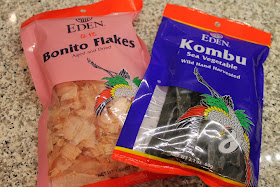 |
| Bonita flakes and kombu are the key ingredients in dashi. |
 |
| Making dashi |
In looking to see what others have gone, I found surprisingly few recipes for salmon braised in dashi. I really liked Myra Kornfeld's recipe, which also includes ginger, soy sauce and sugar. I topped the salmon with fresh chives and served it with corn on the cob--the last for the year from my neighborhood farmers market.
 |
| Poaching salmon in dashi with soy sauce, ginger and sesame seeds. |
Dashi-Poached Salmon
Adapted from Braised Salmon in Dashi by Myra Kornfeld
2 cups dashi (see recipe below)
2 tbsp. soy sauce (may use low-sodium)
1 tbsp. sugar
2 tsp. minced fresh ginger
2 tsp. toasted sesame oil (sadly, I was out of this when I made this, so I tossed a handful of sesame seeds into the mix)
3/4 lb. salmon fillet
2 tbsp. chopped fresh chives
Add dashi to a medium skillet or frying pan with a lid. Bring to a gentle boil. Whisk in the soy sauce, sugar, ginger and sesame oil. Add salmon, skin-side down, cover pan and reduce heat to medium-low to simmer. Cook for about 5 to 10 minutes depending on the thickness of the salmon and how done you like it. Remove salmon from pan, cut off skin and serve topped with a sprinkle of fresh chives.
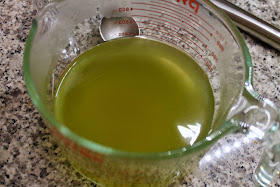 |
| Finished dashi. |
Dashi
Makes 2 cups (multiply recipe as needed)
2 cups of water
1 piece of kombu, about 6-8 inches long
1/4 cup bonita flakes
Add 2 cups of water and kombu to a medium saucepan and soak for 15-20 minutes. Turn on the heat to medium-high and heat until the water is almost boiling (bubbles are just starting to break on the water's surface). Remove from heat and add the bonita flakes. After about 3-4 minutes, strain out the kombu and bonita, leaving the broth. Refrigerate until ready to use, up to 1 week.
Tuesday, October 15, 2013
Caramel Chicken
This recipe, from the latest issue of Bon Appétit, is how I discovered the amazing rice I wrote about yesterday. This dish is also very good: like the best homemade version of General Tso's Chicken you've ever had. Except not deep-fried.
Although not in the original recipe, I recommend spiking it a bit with a pinch of red chili pepper flakes if you want a little heat.
Caramel Chicken
Adapted from Bon Appétit
2 tbsp. vegetable oil
2 lbs. boneless, skinless chicken thighs (I substituted this from the recipe's original bone-in, skin-on chicken thighs)
Salt, to taste
8 garlic cloves, peeled
1/3 cup (packed) light brown sugar
1/4 cup unseasoned rice vinegar
Pinch of red chili pepper flakes (optional, if you want the heat)
2 tsp. minced fresh ginger
1 cup low-sodium chicken broth
1/4 cup low-sodium soy sauce
2 scallions, thinly sliced
Cooked white rice (for serving, see Bon Appetit's incredible rice recipe I discussed yesterday)
1. Heat oil in a large pot (such as an enamel-coated Dutch oven) over medium-high heat. Pat chicken pieces dry with a paper towel, season with salt and, working in two batches, cook in the oil until golden brown and crisp, about 6 to 8 minutes per side. Transfer partially cooked chicken to a plate (it will finish cooking later).
2. Add garlic to pot and cook, stirring frequently, until golden, less than 2 minutes. Transfer to the plate with the chicken. Remove excess fat from the pat.
3. Add 1/2 cup water to pot and use a wooden spoon to scrape browned bits from the bottom of the pot. Add brown sugar and stir to dissolve. Cook mixture, stirring frequently, until it thickens and turns a deep amber color (Bon Appétit's recipe said this would take about 4 minutes, but it took me a lot longer--like 10 to 15. I recommend watching it carefully, since it could burn easily once it thickens).
4. Stir in the vinegar (it may sputter a bit) and continue stirring to dissolve any sugar the vinegar may re-crystallize. If using red chili pepper flakes, add those now. Stir in the ginger, broth and soy sauce.
5. Return chicken to the pot, increase heat to bring mixture to a boil, then reduce heat and simmer gently until the chicken is fully cooked, about 20 minutes. Transfer chicken to a plate.
6. Bring cooking liquid to a boil and cook until thickened, about 10 minutes. Return chicken to pot and stir to coat with the sauce. Serve chicken over cooked rice and topped with fresh chopped scallions.
Monday, October 14, 2013
Perfect White Rice
Do you ever find a recipe for something simple that just blows your mind because it's done so well? That how I feel about the Perfect Pot of Rice recipe from Bon Appétit, which is hands down the best technique I've ever used for making rice at home without a rice cooker. It's another great example of how the conventional wisdom isn't always right.
So let's talk about that conventional wisdom: Most recipes for boiling rice will tell you to employ a 2-to-1 ratio of water to rice, so, typically, you might use 2 cups of water for 1 cup of dried rice, resulting in about 3 cups of cooked rice. For flavor, you might add a little butter, salt or both. Bring the mixture to a boil, cover, reduce heat to lower and cook on a low simmer for about 25 minutes. Uncover and fluff with a fork.
The results are fine, but never really great. There's usually a little moisture left in the bottom of the pot. The grains are cooked but a little soggy. It works fine as a base for a stir-fry, but it's not something you'd probably want to sit there and eat by itself.
This rice I could eat all day. The texture was perfect. Toothy, like al dente pasta, but definitely cooked through. Not at all soggy. Not "sticky" like Chinese rice either. It was really quite impressive.
Perfect White Rice
Adapted from a recipe by Bon Appétit
1 cup long-grain white rice
1/2 tsp. salt
1 1/4 cups water
1. Add ingredients in a 2-3 quart heavy saucepan that has a tight-fitting lid and swirl to combine (do not stir). Turn on the heat and bring to a boil. Cover pot, reduce heat to low and cook for 18 minutes (do not remove lid during this time).
2. Remove from heat. Uncover and place a clean kitchen towel over the the pan then recover (so the towel acts as a barrier between the lid and the rice in the pot). Let rice stand covered like this for 10 to 15 minutes. Remove lid and towel and fluff rice with a fork. Serve immediately or refrigerate for later.
Friday, October 11, 2013
Pumpkin Cocktails
Here's a strange but true fact about pumpkin drinks: a lot of them contain no actual pumpkin. Rachael Ray's Pumpkin Pie Martini? No pumpkin.
This isn't true of just cocktails. Starbucks' pumpkin spice latte, for example, contains the spices common to pumpkin pie (cinnamon, nutmeg and clove), but no actual pumpkin, a fact that dazzled the Daily Mail recently, but which has been pretty well-known for a long time.
For these cocktails, I made a syrup with pumpkin puree and traditional pumpkin pie spices: cinnamon, ginger, allspice, nutmeg and clove.
The pumpkin flavor is subtle but apparent in both drinks. The first is a riff on the classic Sazerac, a drink traditionally not served on the rocks (but I'll admit to throwing in a couple rocks, since otherwise it's rather potent), and the second a refreshing gin drink with apple brandy.
Pumpkin Sazerac
I leaned on Jeffrey Morgenthaler's great piece on the proper technique for making a Sazerac.
Absinthe, scant amount
2 oz. rye whiskey (I used Knob Creek)
1/2 oz. pumpkin pie syrup (see recipe below)
3 dashes Peychaud's bitters
1 dash Angostura bitters
Lemon peel
Add a little bit of absinthe to an empty rocks glass, swirl the liquid around and dump it out. In a separate mixing glass filled with ice, add whiskey, syrup and bitters. Stir until well chilled. Strain mixture into the rocks glass. Twist the lemon peel over the glass to express its oils into the drink; discard peel.
Pumpkin-Apple Sparkler
1 oz. American gin (I used Green Hat gin)
1/2 oz. apple brandy (I used Laird's Straight Apple Brandy)
1 oz. pumpkin pie syrup (see recipe below)
1 oz. fresh lemon juice (juice from 1/2 lemon)
Dash of Angostura bitters
2 oz. club soda
Combine gin, apple brandy, pumpkin syrup, lemon juice and angostura bitters in a shaker with ice. Shake until cold. Pour into a highball glass with ice. Top with club soda and stir to combine.
Pumpkin Pie Syrup
1 cup water
1 cup sugar
1 cup canned pumpkin puree
1 tsp. ground cinnamon
1 tsp. ground ginger
Dash of ground nutmeg
Pinch of ground clove
Pinch of ground allspice
1. Combine all ingredients in a saucepan and bring to a boil, stirring until the sugar has dissolved (it's kind of hard to tell that it's dissolved since the puree makes the mixture cloudy, but after a couple minutes, it will be dissolved). Remove from heat and set aside to cool for about 15 to 20 minutes.
2. Set a fine-mesh strainer over a bowl or glass measuring cup and transfer the cooled mixture to the strainer. Resist the temptation to speed it up with a spatula, since that will force puree through the seive. You should get about 3/4 cup of syrup. Transfer to a sealable container and keep in the fridge.
Thursday, October 10, 2013
Watercress and Fig Autumn Salad
Fall is definitely here now. There's a nice crispness in the morning air again. If we want to eat dinner on our balcony, we have to get out there pretty early. Jackets are starting to come out. Then it will be coats, hats, gloves. You know the drill.
But for now we have fall and with it comes fresh figs. Available year-round in their dried form, there's something much more satisfying about the fleshy sweet fresh kind.
To contrast their sweetness, I paired the figs with floral, peppering watercress; crisp, sharp radishes and some toasted walnuts. A simple balsamic vinaigrette pulls it all together.
Watercress and Fig Autumn Salad
Makes 2 dinner portions
1/3 cup walnut pieces
3 oz. watercress leaves, large clumps torn apart
4 radishes, thinly sliced
1 carrot, peeled and cut julienne
1 oz. prosciutto, cut into narrow strips
3 oz. goat cheese, cut into cubes
2-3 tbsp. chopped fresh Italian (flat-leaf) parsley
2 tsp. good-quality balsamic vinegar
1 tsp. Dijon mustard
2 tbsp. extra-virgin olive oil
Freshly ground black pepper
6 fresh figs, quartered
1. Heat a small frying pan over medium-low heat. Toast walnuts until fragrant, about 7-8 minutes. Set aside to cool.
2. In a large bowl, combine watercress, radishes, carrot, prosciutto, goat cheese and parsley. Whisk together balsamic vinegar and mustard, then whisk in the olive oil. Pour dressing over salad and toss to combine. Season with freshly ground black pepper. Serve in shallow bowls topped with fresh figs.
Wednesday, October 9, 2013
The Feed: October 9, 2013
The Feed is my weekly round up of interesting food-related stories from newspapers, magazines, blogs and websites.
New York Times “A Good Appetite: Spreading Culture - Making Cultured Butter at Home,” by Melissa Clark.
European butter is all the rage in baking these days, often attributed to its higher fat content. But it has a different flavor too—tangier than American sweet-cream butter. Clark explains the reason, which involves culturing the cream before churning it, which isn’t typically done in the United States. She explains how this affects flavor, offers a recipe for DIY cultured butter and includes a fun video of her and others tasting a selection of 13 cultured butters, including her own homemade version.
Washington Post: “‘Cooking slow' offers convenience, in fact,” by Bonnie S. Benwick.
Perhaps because the government shutdown has given me more time to cook lately, I’m more interested in recipes that take longer (which are still great for the weekends under normal circumstances). In reviewing Andrew Schloss’s new cookbook, Cooking Slow: Recipes for Slowing Down and Cooking More, Benwick points out that slow recipes aren’t necessarily more work. She cites a chicken wings recipe that actually has very little “active” cooking time. Also, the recipes just sound really great, like the hanger steak Benwick says becomes “a succulent masterpiece that makes its own demi-glace as it cooks.” I’d definitely eat that.
Food Republic: “Reinventing The Pancake: Mac Cakes Recipe,” by Allison Arevalo and Erin Wade.
Mac & cheese lovers should really make a point of visiting Homeroom in Oakland, California, a great little restaurant with a menu that features a selection of takes on the pasta and cheese classic. Its owners have now put out The Mac + Cheese Cookbook, which includes this unusual (but amazing-sounding) recipe for a mac & cheese pancake. Cool.
NPR: “Is It Time To Cool It On Kale Already?,” by Maria Godoy and Eliza Barclay.
If you’re getting tired of kale, the green du jour for the last 2 years, you’re not alone. On the event of last week’s National Kale Day, Godoy and Barclay examine how some are going overboard in recommending kale-rich diets to the detriment of other foods. It’s an important reminder that balance is more essential to good health than a focus on one, or even a few, so-called “superfoods.”
Wall Street Journal: “Kale Salad With Toasted Almonds and Pecorino Romano,” by Kitty Greenwald
However…If you’re not tired of kale yet, dive into this great kale salad, adapted from Los Angeles chef David Myer’s dish served at Hinoki & the Bird. I like that includes both raw kale and crispy kale chips.
San Francisco Chronicle: “Chefs take on the summer-to-fall challenge,” by Amanda Gold.
Bay Area chefs talk about how the change in seasons from summer to fall is influencing their cooking, including dishes that can be served warm or cold depending on the weather. The story includes recipes for several of the dishes discussed.
GQ: “How to Beat an Overpriced Wine List,” by Alan Richman.
Even if you feel pretty confident with restaurant menus, their wine lists can still be intimidating. So many unusual varietals, wineries you haven’t heard of and prices you probably don’t want to pay unless you’re sure you’re getting something good. And even then, you know you’re paying a big mark up. Richman offers a number of tips for successfully navigating the wine list with confidence.
New York Times: “The 12 Best Restaurants in New York for Wine,” by Pete Wells.
If Richman’s piece inspires you to dive into an interesting wine list, Wells’ story offers a great selection of some of New York’s best examples, with tips for finding value and unusual bottles among them.
Los Angeles Times: “For beer lovers, now's the time to appreciate the freshest hops,” by John Verive.
It’s time for the hop harvest, which means the seasonal release of “fresh-hop” brews. Verive explains what they are, along with some other useful hop terminology. I’m definitely going to be looking for some of these beers, like Deschutes Brewery’s Chasin’ Freshies and Hop Trip.
Food 52: “5 Handy Facts About Baking with Parchment Paper,” by Alice Medrich.
If you haven’t yet discovered why parchment paper is an essential baking tool, Medrich shares a few reasons why you should really stock this in your pantry.
Reuters: “Just what is in that chicken nugget?,” by Kathryn Doyle.
The answer’s not as bad as you might think, although it’s really not that great either.
Food & Wine: “95 Ways to Amp Up Thanksgiving” (November issue)
The content doesn’t appear on the site yet, but The November issue of Food & Wine is already out and focuses on Thanksgiving with some pretty amazing-sounding recipes: galette starters, spinach spoon bread, apple-brined turkey and lemon-cranberry pie bars, to name just a few of the mouth-watering options.
Note: The Feed will be taking the week off on October 16.
Tuesday, October 8, 2013
Stuffed Acorn Squash
Last year, I tested a stuffed squash recipe and I was so unhappy with it that I never bothered writing about it. Now that I have a great recipe to share, I'm ready to talk about why it failed.
My previous attempt involved delicata squash stuffed with a mixture of onions, nuts, herbs and cheese. In concept, it was a beautiful recipe. In practice, it didn't quite work, in ways similar to why roasted stuffed turkey doesn't always work.
A baked stuffed squash is going to be tricky because you're combining two concepts that may require different cooking times. This is the same problem with a stuffed turkey--to be sure the stuffing is thoroughly cooked, you risk over-cooking the turkey. With a stuffed squash, since the filling is mostly already cooked, you risk overcooking the filling to ensure the squash is done (or undercooking the squash to ensure the filling doesn't burn). It's catch-22 unless you can get it just right.
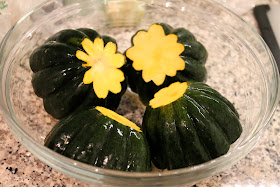 |
| Arrange the squash in microwave-safe bowl as shown for cooking. |
My results were a compromise between these two extremes, which means that neither the squash nor the filling was satisfying as I'd wanted: the squash, slightly undercooked, was too hard and the filling, slightly overcooked, a bit dry. There had to be a better way.
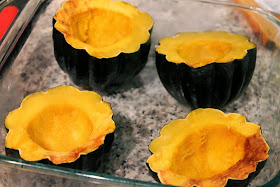 |
| The squash came out of the microwave looking like this: thoroughly tender and slightly browned. |
This stuffed acorn squash recipe addresses that problem beautifully: don't attempt to bake the squash stuffed. Problem solved! Here, the squash is cooked separately and the two halves are joined at the end. Does the dish suffer from this? Not at all. The resulting stuffed squash was beautiful and flavorful, with both the vegetable and its filling cooked just right.
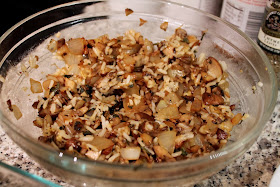 |
| This basic onion, mushroom and rice filling can be adapted as you please, perhaps some chopped nuts (hazelnuts? pecans?) a different cheese (parmigiano-reggiano?) or herbs (parsley?). |
I hit on this idea from Martha Stewart's stuffed squash recipe. Her recipe finishes the dish under a broiler to melt its cheese topping. I incorporated the cheese into the filling, so this last step was not necessary. I also did not roast the squash. Instead, as recommended by America's Test Kitchen, I cooked it in the microwave, which was really easy and saved time.
Stuffed Acorn Squash
Adapted in part from Acorn Squash Stuffed with Mushrooms and Rice by Martha Stewart
2 acorn squash, cooked in the microwave (see recipe below)
1 or 2 tbsp. extra-virgin olive oil
1 medium yellow onion, minced
8 oz. cremini onions, stemmed and finely chopped
Salt, to taste
1/2 tsp. dried thyme
2 tbsp. chopped fresh sage
Freshly ground black pepper
1/2 cup cooked white rice
1 oz. finely grated aged gouda cheese
2. Place the cooked squash cut-side up on a serving plate. With a large spoon, fill the cavity of each squash half, pressing down gently to compact filling. Slightly mound filling for each (there should be just enough filling for the four halves). Serve immediately.
Simply Cooked Acorn Squash
Adapted from Acorn Squash with Brown Sugar by America's Test Kitchen
Note: Because I was stuffing the squash, I did not follow the final step of broiling the squash with butter and brown sugar.
2 acorn squash, halved and seeded, with bottoms sliced off so they sit upright if necessary
Salt, to taste
1/4 cup water
1. Sprinkle cut sides of squash with salt. Place cut-side down in a microwave-safe bowl so that the cut sides face out (as shown in the photo above). Add water to bowl. Cover bowl tightly with plastic wrap. Poke 4 steam vents into the top of the plastic.
2. Microwave on high until the squash is very tender, 15 to 25 minutes (mine was nicely done in 20). Remove from microwave (careful, the bowl will be very hot). Allow to cool slightly, then carefully remove plastic wrap.
*If you want to serve the squash by itself, here are the additional steps America's Test Kitchen included for serving with butter and brown sugar. Note that I did not test this preparation but am providing FYI.
3 tbsp. unsalted butter
2 tbsp. dark brown sugar
1/8 tsp. salt
Adjust oven rack to uppermost position (about 6 inches from heating element) and preheat broiler. Melt butter, sugar and salt in a small saucepan over low heat until combined, whisking occasionally.
Transfer cooked squash cut-side up to a rimmed baking sheet. Spoon the butter/sugar mixture onto each squash half. Broil squash until brown and caramelized, about 5 to 8 minutes, rotating baking sheet as needed. Remove squash when done and serve immediately.








